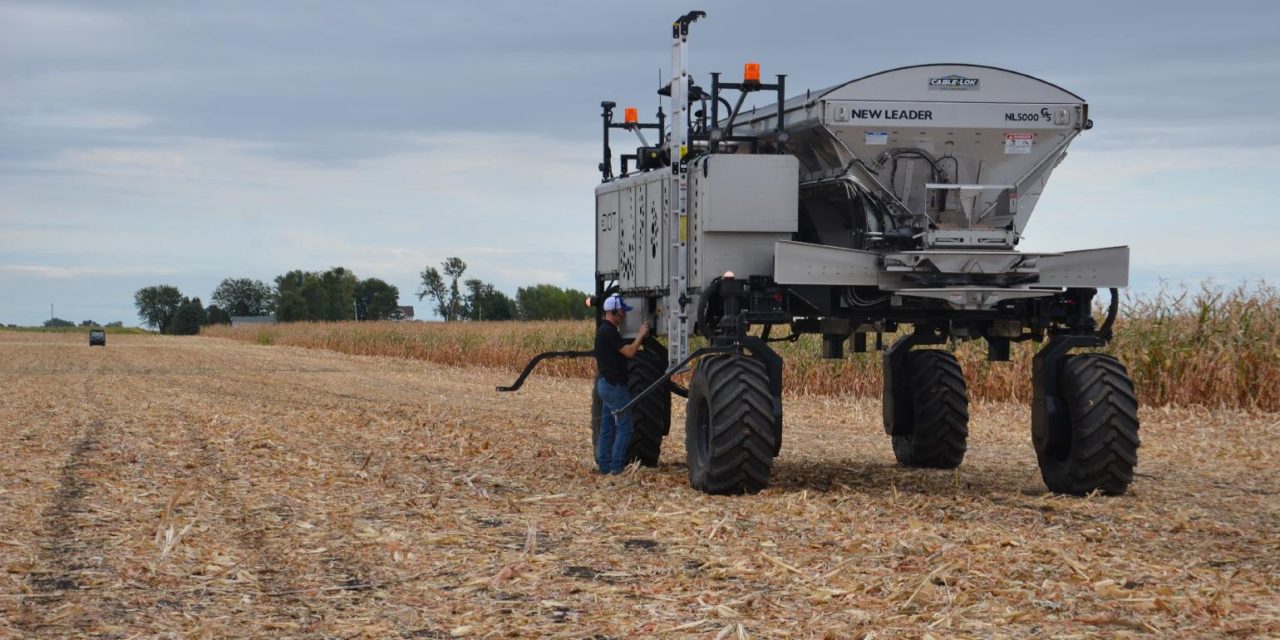PREPARE TO LAUNCH: A technician checks final settings on this autonomous Dot fertilizer applicator before turning it loose to apply fertilizer on 40 acres at the Farm Progress Show site near Boone, Iowa.
By Tom J Bechman
Source: www.farmprogress.com, January 2021
Ag engineers from across the country look at the opportunities and challenges associated with robots in agriculture.
For someone who once rode on a Massey-Harris 44 tractor with a two-row mounted cultivator with his dad, it was an almost unbelievable scene. A technician stood by a large, self-propelled fertilizer application machine. The Dot applicator, powered by Raven technology, was going to broadcast phosphorus and potassium fertilizer per prescription on 40 acres after corn harvest. Once the technician was assured settings were right, he would step away, and the machine — with no one aboard — would complete the task.
Meanwhile, Willie Vogt, editorial director for Farm Progress, would follow in a John Deere Gator, filming the machine for the Farm Progress Virtual Experience. Visit FPVExp.com.
ogt noted that he got a little close and later found fertilizer in his pants cuffs. The fact that the machine did exactly what it was programmed to do is the opportunity of the future, ag engineers say. Fertilizer in pants cuffs represents the challenge. How will companies and society deal with safety and liability issues?
Closer look
Santosh Pitla, associate professor at the University of Nebraska-Lincoln, chaired a committee that prepared a Council for Agricultural Science and Technology issue paper, Ground and Aerial Robots for Agricultural Production: Opportunities and Challenges.
Pitla; Tami Brown-Brandl, also of UNL; Dennis Buckmaster, Purdue University ag engineer; and Scott Shearer, Ohio State University ag engineer, were all involved with the paper.
“We see unmanned ground vehicles used in both row crops and specialty crops, and unmanned aerial systems, commonly called UAVs, used for sensing and application,” Pitla says. Then there is a new class: robotic manipulators, with application in greenhouses and in phenotyping for crop research, as well as in livestock systems and with specialty crops.
For autonomous robots to be practical, they must diagnose their own problems on the go. As early as 2013, Pitla and Shearer commented that if a tillage tool plugs with residue, a spray nozzle plugs or a bearing on a planter row unit goes out, the machine must diagnose and resolve the problem on its own. Impossible? Not necessarily, they note. Enter artificial intelligence, which is already helping smartphone apps identify weeds in the field today.
The CAST committee led by Pitla reached six recommendations for the future if these systems are to become an integral part of agriculture:
- More research is needed to show that these new tools offer a return on investment. Otherwise, producers will be slow to adopt them.
- Rural high-speed broadband connectivity is essential for successful deployment of ground and aerial robots. The patchwork system that currently exists, where some rural areas have fast internet and neighboring farms don’t, won’t cut it.
- Safety, operational and performance standards must be developed. Without these, both existing equipment companies and startups will be throttled by liability concerns.
- Universities, government agencies and the private sector need to initiate a dialogue about data privacy, security, ownership and transparency in agriculture. The data ownership issue cropped up over two decades ago as precision ag emerged, but still hasn’t been addressed on an industry-wide scale.
- The regulatory environment must keep pace as agriculture changes, with more work done by robots and less reliance on human labor.
- Robust educational programs are needed to update policymakers about technology expansion in agriculture.

